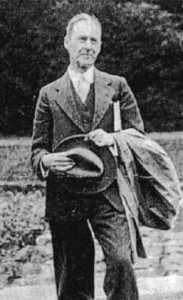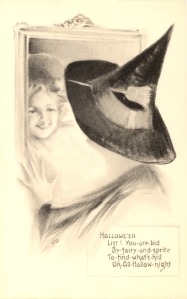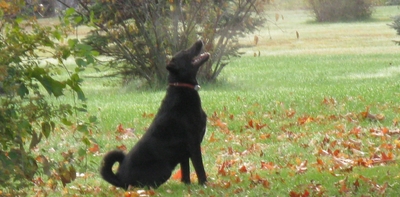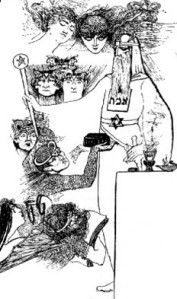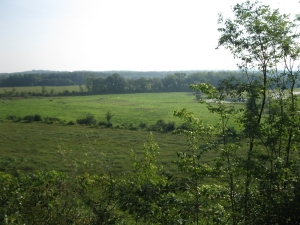
The setting. Click to enlarge.
This morning I was walking up a steep hill which overlooks dairy pastureland. The view below charms the eye. Cows graze amid sparse trees and hedgerows scattered in a broad field with a narrow crooked pond. The composition is painterly. It is the perfect background to frame something aloft.
A peregrine falcon called from nearby trees. I heard the sound but it didn’t register. She called again (unlike songbirds; both sexes of falcon call), and this time I looked up. When I did, the bird launched from her perch to begin a shallow descent, turning a broad arc over the pastureland. For five long seconds, with exquisite precision, the falcon positioned herself to become the someone aloft who imparted balance, harmony and focus to the pastoral scene.
Her flight ended in the crown of a tree rooted in the pasture below. As she took her time folding up her wings, the thought occurred that the falcon wouldn’t have improved the composition or have been framed so well by it if she had flown directly to her new perch. This falcon who twice announced her departure literally went out of her way to be seen in flight just where she was seen. It seemed as if she knew what effect her flight and its calculated path would have on this passerby.
To have that intention would require aesthetic sense, a hunch that a different species could share her aesthetic sense, and a willingness to exert herself to create an ephemeral beauty that neither she nor any of her kind would see. Upon what I cannot prove, I will not insist. To seem and as if are the verbal shields against the dreaded charge of unwarranted anthropomorphization.
I resumed my walk, thinking about what I’d just seen. Closer to my destination, the road passes beside a neighbor’s lawn. As I walked by, another peregrine landed on the lawn at close social distance, just ahead of me and to the side. He remained there for several seconds, while we exchanged acknowledgments. I rarely see hawks close-up on the ground. They are vulnerable there. He seemed confident of his safe reception, as well he might be, but objectively he was taking an avoidable risk.
In his own good time, he flew to a tree at the far end of the property. His ascent allowed him to show his plumage – and his talons. He crisply launched from the tree into a flight across the lawn, almost directly at me at chest height. My turn to be confident that this was not an attack, but an air show. And so it was. He broke off to perch in another tree at the margin of the road, just overhead. He paused there for one last exchange of acknowledgments and then was on his way.
A synchronicity is Carl Jung’s term for the occurrence of two or more events close together in time that are related by complementary meaning but have no apparent causal connection. The second hawk answered some of my questions about the first, such as whether a falcon would go out of her way to make contact across species lines, and whether she would intentionally show off (in candid truth, I have long believed that hawks do sometimes enthusiastically show off).
What sense of visual aesthetics hawks might have, and the degree to which their sense might be held in common with other sight-oriented species like us is harder to say. I have my suspicions, though.

